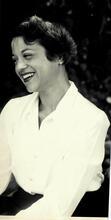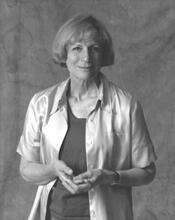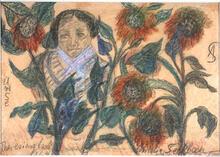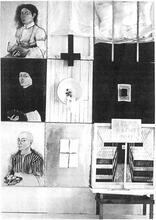Lucille Corcos
Lucille Corcos was celebrated as one of the foremost “modern primitivist” painters in America, creating revealing composite urban scenes. She trained at the Art Students League and earned her first cover commission at Vanity Fair. She rapidly began illustrating books for adults and children with lush colors and playfully warped perspective. Her works included illustrated versions of Nikolai Gogol and the Brothers Grimm, as well as the Illustrated Treasury of Gilbert and Sullivan in 1940. Corcos exhibited widely, regularly showing her work in the Whitney Biennial and at the Metropolitan Museum of Art, the British Museum, the Art Institute of Chicago, and the Tel Aviv Museum of Art. She also created a mural that remains on display at the Waldorf-Astoria in New York City.
Article
Lucille Corcos was, for some thirty years, the doyenne of the “modern primitivist” trend on the American art scene. Her paintings, with their composite urban scenes, are often views into various buildings that the observer generally sees only from the outside and in passing; Corcos turns them inside-out before the eye of the viewer. The work is literally “revealing.” As such, it is touching, witty, and thoroughly delightful to contemplate. Though Corcos paid little heed to conventions of scale and perspective, her work is far from abstract, and her renderings are painterly and nuanced.
The daughter of Amelia (Abrams) and Moroccan-born Joseph Corcos, the rabbi of Congregation Shearith Israel, New York’s Spanish-Portuguese synagogue, Corcos made her earliest forays into the world of the fine arts creating illustrations for certificates celebrating special occasions in the lives of her father’s congregants. Trained under Jean Matulka during the heyday of the Art Students League, Corcos began her professional career in 1929 with a move from Manhattan to Brooklyn Heights where she produced several illustrated children’s books, which editorial consensus deemed too sophisticated to publish. Frustrated, Corcos took the illustrations to the offices of Vanity Fair, where she received a cover commission on the spot. Her work subsequently became quite popular, and she illustrated a number of books for children as well as for adults. While their parents appreciated Corcos’s elegant and charming compositions, children, no doubt, were drawn in by her playful sense of line, and many of her books quickly became classics. One example is the Illustrated Treasury of Gilbert and Sullivan (1940), which she conceived, and which rivals Gilbert’s own Bab Ballads for its charming and sophisticated illustrations.
By the mid-1930s, Corcos was exhibiting widely, participating often in the Whitney Biennial; in the 1940s, her work was exhibited at the Metropolitan Museum of Art, the British Museum, the Art Institute of Chicago, the National Academy of Design, and many other museums. Later in life, she exhibited at the Tel Aviv Museum of Art. She traveled extensively throughout Europe and South America and executed a significant public mural, which remains on view, in the Waldorf-Astoria in New York City.
Corcos was widely praised for her lack of self-consciousness and complete freedom of expression, for knowing the ropes of academic illusionism, yet rejecting it in her quest for spontaneity and freedom. Her ability to combine simplicity, intelligence, and creative flair in her work earned her a place with her contemporaries John Kane and Horace Pippin as an exemplar of a buoyant and playful, robust, nativist, unacademic tradition of naive art in America.
Boni, Margaret Bradford, Norman Lloyd, and Lucille Corcos. Songs of the gilded age. Golden Press, 1960.
Lucille Corcos, 1908–1973 (1992).
Sullivan, Arthur, Lucille Corcos, W. S. Gilbert, Deems Taylor, and Albert Sirmay. 1941. A treasury of Gilbert & Sullivan; the words and the music of one hundred and two songs from eleven operettas. Edited by Deems Taylor, illustrated by Lucille Corcos; arrangements by Dr. Albert Sirmay. New York: Simon and Schuster.
Wisotzki, Paula. "Dorothy Dehner and World War II: Not Just Life on the Farm." Archives of American Art Journal 55, no. 1 (2016): 4-25.











